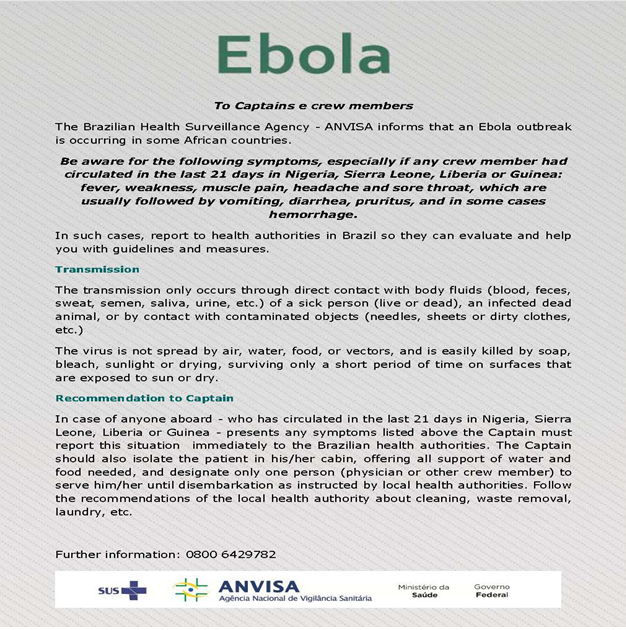西アフリカにおけるエボラ出血熱の流行について(その14)
- 外航
試 訳
EBOLA VIRUS – South American Countries
エボラウィルスの流行及びそれに伴う南米諸国への影響を鑑み、SAPIC(South American P&I Correspondents)加盟コレスポンデンツは南米諸国における状況に関するサーキュラーを発行することを決定しました。各国状況の詳細は以下の通りです。
ARGENTINA
Centro de Navegacion (同国local agentsのグループ)発行のサーキュラーによると、エボラウィルス感染地域から来る船舶に対しPilotが取るべき予防措置に関してSanitary Authoritiesから明確な指示がないことに鑑み、River PlateでPilotサービスを提供するPilots会社は、エボラウィルス感染地域(Guinea, Liberia, Nigeria, Sierra Leone)寄港から30日以上経過するまでは同地域に寄港した船舶へのPilotの配乗を行わないことを決定しています。
一方、Centro de NavegacionはSanitary Authorityに対し、感染地域から来る船舶への対処に関する措置を定めるよう要求する書状を出しています。
上記状況から、エボラウィルス感染地域から来る船舶は、River Plateエリア到着前に予めlocal agentsに相談することをお勧めします。
なお、最新情報によるとPilot乗船の待機期間は30日から21日に短縮されることが決定した模様です。
情報提供:Pandi Liquidadores SRL, Buenos Aires
BRAZIL
1) Port of Santos
現在のところ、アフリカから来る船舶に対して特段の措置は取られておらず、International Health Regulationに規定されている手続が取られていますが、Guinea, Liberia, Sierra Leone及びNigeriaから来る船舶はより厳しい検査の対象になる可能性があります。
伝染病であるため、エボラウィルスは通報が義務付けられている疾病であり、感染あるいは感染の疑いの通報を怠った場合、関連の衛生規則違反に加え刑事犯罪にもなるので、感染もしくは感染が疑われるケースは速やかに通報する必要があります。
情報提供:Representacoes Proinde Ltda., Santos
2) Port of Paranagua
2014年8月18日に現地National Health Surveillance Agency(ANVISA)主催のpublic meetingが開催され、以下の情報が提供されました。
現在のところアフリカから来る船舶に対する検疫は課せられていないが、入港許可取得のためには通常の手続きを取る必要がある(最初のBrazilian port到着の48時間前に本船上のhealth conditionを通知すること)。但し、西アフリカの感染地域から来る船舶は通常の無線による入港許可は認められず、Health Authority Inspectorによる検査を受ける必要があり、感染者がいないことが確認された後入港が許可される。
ANVISAは船員向けに以下の案内書を発行しています。

情報提供:Van Herp & Frumento (P&I Services) Ltda., Paranagua
CHILE
情報収集中。
MEXICO
Guinea, Liberia, Sierra Leone及びNigeriaにおけるエボラウィルスの状況に関し、Mexican Health Ministryより以下の通知がなされています。
エボラウィルスは、発熱、極度の衰弱、筋肉痛、頭痛、喉の痛み、嘔吐、下痢、発疹、腎臓及び肝臓不全を伴う急性の深刻な症状を引き起こす。また、致命的な内外出血を引き起こす場合もある。
ウィルス感染はアフリカ大陸、特にGuinea、Liberia、Sierra Leone及びNigeriaで発生している。アフリカ大陸以外では、United States及びSpainで2件ずつ感染が報告されている。当該患者は治療のためアフリカから本国に移送され隔離されているため、感染が拡大するリスクはない。
World Health Organization (WHO)はプレスリリースを発表し、その中で西アフリカにおけるエボラウィルス流行を異常事態とし、他国の公衆衛生に対する危険であると述べている。また、WHOは現在の流行に対処するための勧告を発表している。
Mexican Ministry of Healthは、Official Websiteで8月1日に発表した予防措置及び感染国への渡航自粛を勧告したTravel Preliminary Noticeを再度勧める。
- 感染者の血液及び体液に触れないこと。
- 感染者の血液及び体液が付着した器具に触れないこと。
- 感染の恐れがある動物(猿、レイヨウ、蝙蝠、チンパンジー)に触れないこと。
- 感染の恐れがある遺体や動物の死骸に触れないこと。
- 渡航後21日以内に発熱、筋肉痛、喉の痛み、下痢、胃痛、目の充血がある場合には、即座に治療を受けること。
Mexico到着まで症状が続く場合、客室乗務員または入国管理官に申告すること。
症状の申告は入国を禁止する目的ではなく、治療を提供する目的である。
なお、Mexicoでのエボラウィルス感染また感染の疑いは報告されていません。この点、2014年8月7日にMexican State of CoahuilaのMinistry of HealthはMexican News Agencyを通じ同国でのエボラウィルス感染ケースはない旨のプレスリリースを発表しています。
(http://www.notimex.com.mx/acciones/verNota.php?clv=158795)
CoahuilaのMinistry of Healthによるプレスリリースは以下の通りです。
Saltillo, Coahuila, Thursday, August 7, 2014
CoahuilaのMinistry of Healthは以下の通り発表する。
2014年8月6日、Mexico City出身の学生がエボラウィルスに感染した疑いがあるとのニュースが広まった。同ニュースはCoahuilaの新聞により掲載された。即座に当局は調査を実施し、誤報であることを確認した。
Mexicoにおけるエボラウィルスの広報担当であるDr. Cuitlahuac Ruiz Matusは同国でのエボラウィルス感染ケースはないと述べています。
CoahuilaのMinistry of HealthはNational Health Systemに属しており、Federal Governmentとともに監視を続けています。
Mexican Ministry of Healthによるnews release、facts sheets及びその他は次のウェブサイトで確認できます。www.salud.gob.mx
情報提供:P&I Services Mexico S.A. De C.V/, Mexico
VENEZUELA
Venezuela政府は、アフリカ(特に西アフリカ)発着のフライトを禁止する措置を取っており、これにより西アフリカ諸国からの密航者の取り扱いが困難になっています。現在のところ船舶の航行に関する規制はありません。港湾関係での対応として同国政府により取られている措置としては、港湾内の検疫所のドアと窓が補強されたことだけとのことです。
http://www.eluniversal.com/vida/140811/venezuela-se-prepara-ante-brote-de-ebola-en-africa
情報提供:Venepandi, C.A./Caracas, Venezuela
URUGUAY
同国Pilotsは、エボラウィルス流行国から来る船舶について当該港出港後21日以上経過するまでは乗船しないことを決定しています。
Sanitary Authoritiesは、エボラウィルス感染または疑いがあるケースに対する措置及び指示を出しています。
Sanitary Authoritiesにより出されたContingency Planは以下の通りです。
“Objective
The actions of sanitary and epidemiological controls have as purpose to early detect the infect contagious diseases arriving to the national territory.-
PLAN OF CONTINGENCY
In case of any vessel coming to Uruguay with one or more passengers or crewmembers with symptoms compatible with EVD (sudden fever, intense weakness, muscle pain, headaches, sore throats), the following protocol will be applied:
1. If detected during the voyage:
As soon as the Master is aware of the fact that a crewmember on board has symptoms compatible with EVD, he should immediately notify to the Control Station/Agents, requesting that a message be passed to the Coast Guard. Said message should include:
- Signal call number of the vessel
- Prior called port
- Destination port
- ETA
- Number of affected people
- Number of people on board
- And the expression “transmissible disease”
The Control Station must notify to:
- Sanitary authorities
- Port authorities
- Migration authorities
- Vessel’s Agents
- Customs’ Authorities
The above authorities will meet immediately at the Coast Guard offices and the Contingency Plan against EVD will be activated, in order to coordinate the procedures to be applied.-
Initially, the vessel will be anchored in a remote area as far from other vessels as possible, and she will keep flag Q at the top.-
Nobody will be allowed to have access to the vessel, without authorization from the Coast Guard.-
The Coast Guard will provide with an appropriated vessel to carry the Sanitary Authorities, who once having the personal protective equipment (PPE) could board and contact with vessel’s authority in order to know in detail the situation on board and, mainly, the status of the passengers/crew with symptoms.-
Any passenger or crewmember with the above mentioned symptoms and clinical signs, will be authorized to disembark and once ashore will be moved to a health institution by means of an ambulance prepared for such purposes, for his medical and epidemiological control. In the meantime the other passengers and crewmembers will remain on board the vessel, awaiting orders from Sanitary Authorities.-
Migration Authorities will control the documentation, with EPP, on board or where ordered by the Coast Guard.-
If confirmed the person is suspected with EVD, the other passengers and/or crewmembers should complete the “Voyager Health Statement”.-
After the evaluation, if the person is considered suspected with EVD, the contacts should be established as per the protocol “Evaluation of Risks for diseases contracted during the voyage”, which considers as contact all the passengers/crewmembers on board. The contacts should be evaluated in the area assigned within the port. In case of a transit passenger/crewmember, the country of destination should be notified for monitoring the person during 21 days. For those established in the own country, same should be monitored during 21 days, according to WHO’s requirements.-
The crew considered with suspected cases, will be moved to a healthy institution, in a special ambulance, which will be at the pier.-
The vessel will remain under sanitary observation until disposed by Sanitary Authority. Same could be released only after authorized, and its hygiene and disinfection (carried out according to WHO’s dispositions) be evaluated and approved subsequently.-
If from the medical and epidemiological evaluation, it does not arise any sign of risk, which could classify same as suspected of EVD, the Sanitary Authority will release the vessel, its crew and passengers and will issue the corresponding Certificate, taking out the flag Q.-
2. If the Owners are aware of the situation previous to departing
The Agents will notify to the Coast Guard, which will inform the Sanitary Authority, implementing the necessary measures for the case, impeding the departure of the suspect, establishing contacts and fulfilling the same proceeding as in numeral 1.-
3. Vessels coming from countries considered of High Risk
The Sanitary Authorities could dispose of a point of observation for disembarking the passengers.-
4. The passengers departing from a country considered of High Risk
The Agents will notify to the Coast Guard, which will put in notice to the Sanitary Authorities.-
The Sanitary Authorities could dispose of a point of observation for disembarking the passengers.-
The cleaning and disinfection of environ areas are important compounds in the control of infections and the same general regulations as stated by WHO should be applied for a possible case of EVD. The ambulance should be cleaned and disinfected with a hypochlorite solution at 0.05%. Regarding the vessel, as per WHO requirements, the disinfection will be carried out with products compatible with the area to be cleaned.-
The people in charge of the cleaning, as well as those in contact with the suspected person, should employ the PPE, which consists of waterproof gloves, waterproof gowns, mask N95, ocular protectors and closed shoes.-”
同国諸港に寄港する船舶は、感染が疑われる兆候(発熱、嘔吐、頭痛、等)を示している船員がいる場合、現地代理店を通じて当局に対し通知することをお勧めします。
情報提供:Chadwick Weir Navegacion SA, Montevideo
エボラウィルスに関する状況は日々変化していますので、寄港前に現地代理店に確認し最新情報を入手して下さい。




